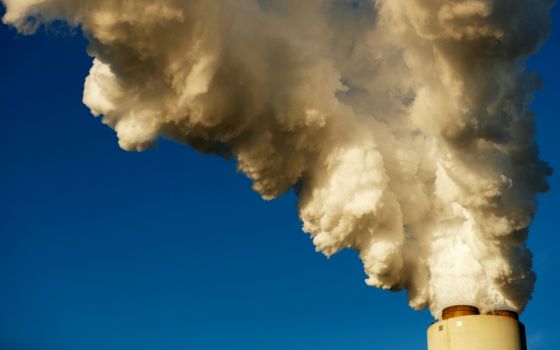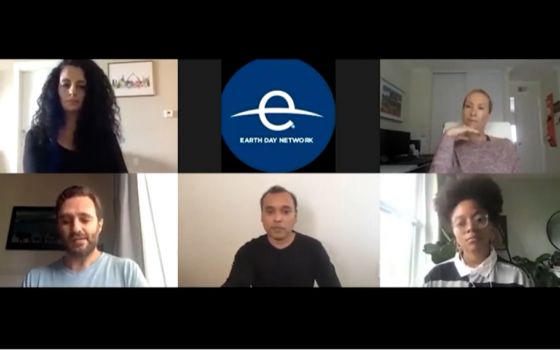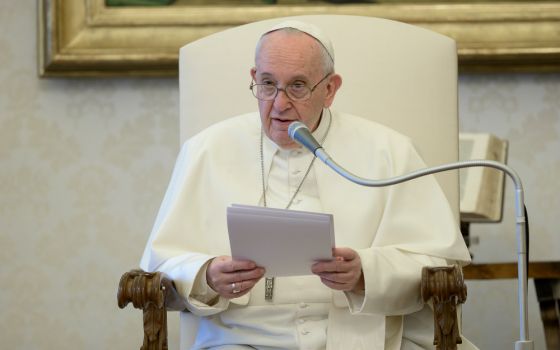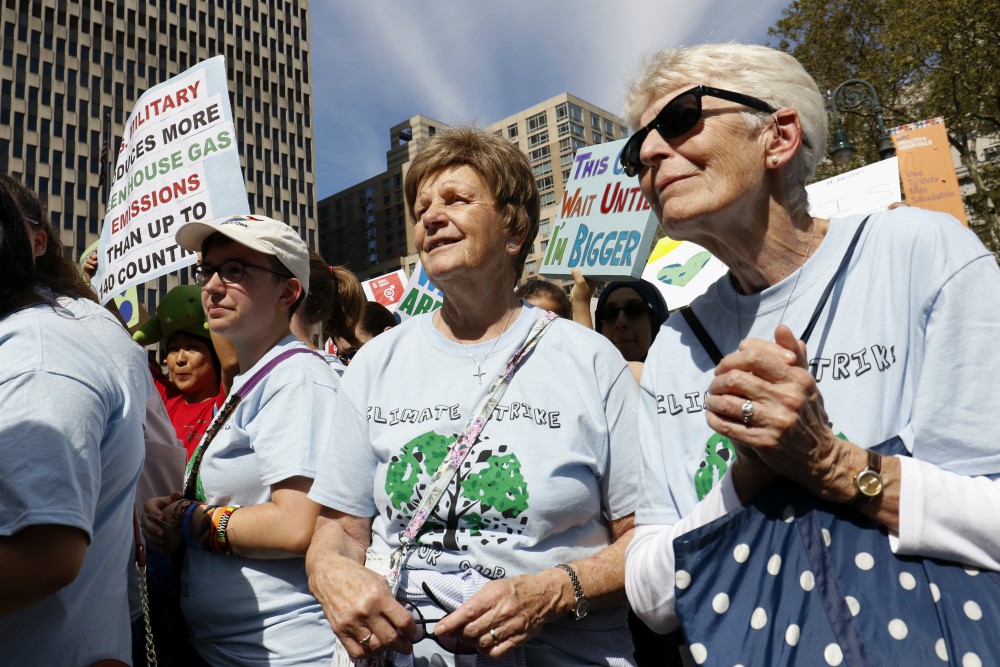
Sr. Helen Kearney, center, president of the Sisters of St. Joseph of Brentwood, New York, and St. Joseph Sr. Mary Doyle, right, participate in the Global Climate Strike in New York City Sept. 20, 2019. (CNS/Gregory A. Shemitz)
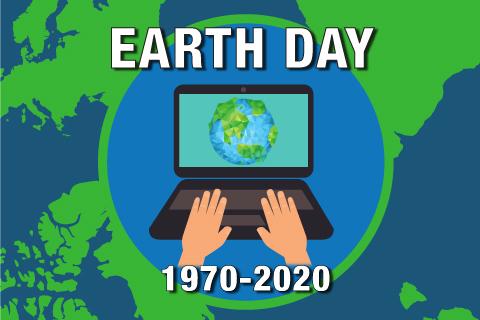
(NCR graphic/Jesse Remedios and Toni-Ann Ortiz)
On the first Earth Day on April 22, 1970, Catholic women religious were among the more than 20 million people across the country who demonstrated on behalf of planet Earth and aroused a mainstream America that was largely oblivious to environmental concerns and how a polluted environment threatens human health.
Such issues, though, were not new to those divinely inspired sisters.
Recitation of a Creed: Do you really believe it?
What was new to them was the challenge to first link the opening of the Nicene Creed recited at Mass — "We believe in one God, the Father, the Almighty; maker of heaven and earth, of all that is seen and unseen" — with the renewed, post-Vatican II understanding of the deep connection between the doctrines of Creation, Incarnation and Redemption, and the ecological spirituality of their particular charisms, e.g., Benedictine, Dominican, Franciscan. Secondly, sisters needed to develop and assist the faithful in discovering a religious and moral imagination for their Christian vocation to care for God's creation.
Sadly, 19th- and 20th-century biblical positivism, combined with resistance by theologians to engage in dialogue with modern sciences concerning biological evolution, resulted in the virtual surrender of issues concerning the relationships of God and humans with the natural world to science alone. Catholic theology posed "special creation" — a theological doctrine that states the universe and all life in it originated in its present form by unconditional fiat or divine decree — which conflicted with Darwinian evolution. Further, a literal interpretation of "dominion" in Genesis 1:26-28 claimed the Divine granted unfettered license to humans to exploit the nonhuman natural world with impunity.
Before the Second Vatican Council, most women religious had virtually no access to graduate theological education. They depended on catechetical sources that touted hierarchical, anthropocentric and often legalistic interpretations of human relationships with God's creation. Though Pope Pius XII's Divino Afflante Spiritu (1943) and Vatican II's Dei Verbum (1965) served to correct prior inadequate biblical interpretation, it was well into the 1970s before Catholic theologians published accessible texts that supported a renewed "ecotheology" or "ecological ethics."
In spite all of this, women religious carried on, rooted in deep faith and commitment to God, their Creator. Sisters had a long track record of ministering to the wide variety of God's people in hospitals, orphanages, parishes or schools — and more.
Advertisement
While caring for victimized people, they frequently experienced firsthand the hegemonic powers that created the planetary degradation and destruction that was exposed on that first Earth Day. The situations Rachel Carson's 1962 New York Times bestseller Silent Spring unveiled were familiar to sisters, who accompanied migrant farmworkers suffering mysterious illnesses and deadly cancers. But the official church had said little about the environmental issues that Carson raised.
Recognition: How could we forget it?
In the 1970s and '80s, women religious retrieved the sources of their charisms and discovered that their founding spiritualities sang in harmony with renewed biblical interpretation, confirming a moral mandate for humans to be the guardian protectors of all of creation. Most spiritualities echoed St. Augustine's observation:
Some people, in order to discover God, read books. But there is a great book: the very appearance of created things. … Note it. Read it. God, whom you want to discover, never wrote that book with ink. Instead He set before your eyes the things that He had made [De Civitatis Dei, Book XVI].
Exemplary founders and saints include Hildegard von Bingen, Julian of Norwich, Meister Eckhart, St. Francis of Assisi (made patron saint of ecologists in 1979) and St. Bonaventure. The strong message that echoes through such spiritualities is that it is idolatrous to claim to worship God while destroying — often knowingly — God's creation.
Gradually, Catholic social teaching by Popes Paul VI and John Paul II began to address socioeconomic issues, but explicit mention of environmental justice as moral duties of Christians remained quite tangential. The U.S. bishops' 1986 document "Economic Justice for All" did, however, call for an environmental ethics.
The next year, the United Nations' Brundtland Commission published its Our Common Future report. It defined "sustainability" but without distinguishing what is to be sustained, for whom and for how long.
Also published that year was the United Church of Christ racial justice commission's report on toxic waste sites and race in the United States. The report exposed situations all too familiar to sisters who had consistently ministered among people burdened by poverty, racism and violations of labor rights and civil rights, and they joined in what became the environmental justice movement.
In his landmark 1990 World Day of Peace message, "Peace With God the Creator, Peace With All of Creation," John Paul II clearly named environmental justice and sustainability as moral issues, charging Catholics with environmental duties as moral obligations.
Finally, in 1991, the U.S. bishops published "Renewing the Earth," which addressed "sustainable development," integrating environmental health, economic development and social equity.
But sadly, the past inadequate theological and ethical catechesis concerning creation, ecology and creation care hobbled efforts to engage the religious imagination of ordinary faithful, who often dismissed it as ideology or idealism.
Reparations: Do we have the courage to restore creation?
In the new millennium, a deep integration of their religious vocations and renewed spiritualities empowered Catholic sisters to creatively focus their mission on ecological justice issues.
Sisters became as articulate in solar technology as they are in the Gospels. With diverse education and training, they now fill new roles, challenging structural injustices in new ways. Today, grounded in their Catholic faith, they model the Christian ecological vocation, restoring life to people and the planet.
Authenticity and inspired commitment are contagious. Nothing is more convincing than the actual witness of women religious — they practice what they preach!
Numerous communities of sisters have converted their residences and motherhouse campuses into showcases, which are open to the public, of genuine sustainable living. Sisters freely share knowledge and offer spiritual direction. A "green economy" is demonstrated daily by women with vibrant spiritual lives.
Caring for God's creation opens everyone to the beauty, wonder and healing Presence — the One who became one of us (Incarnation) in order to make us one (Redemption). In his encyclical "Laudato Si', on Care for Our Common Home," set to mark its own anniversary this year, Pope Francis confirmed what sisters have known and acted on for over 50 years:
There needs to be a distinctive way of looking at things, a way of thinking, policies, an educational program, a lifestyle and a spirituality which together generate resistance to the assault of the technocratic paradigm. Otherwise, even the best ecological initiatives can find themselves caught up in the same globalized logic [Laudato Si', 111].
[Franciscan Sr. Dawn M. Nothwehr holds the Erica and Harry John Family Endowed Chair in Catholic Theological Ethics at Catholic Theological Union.]





